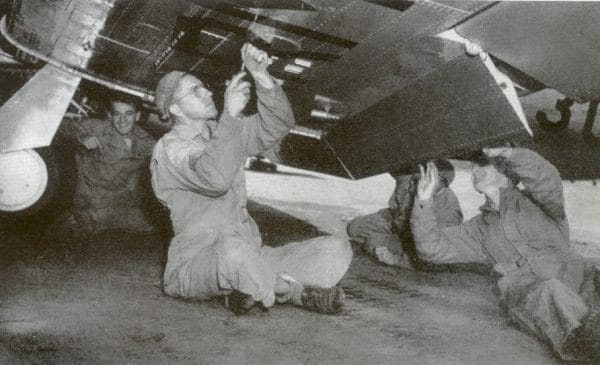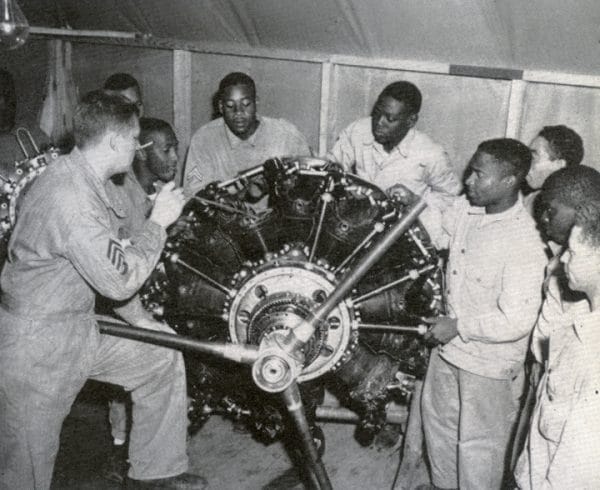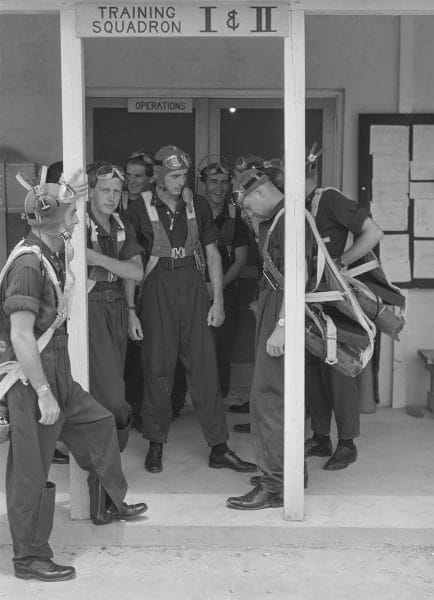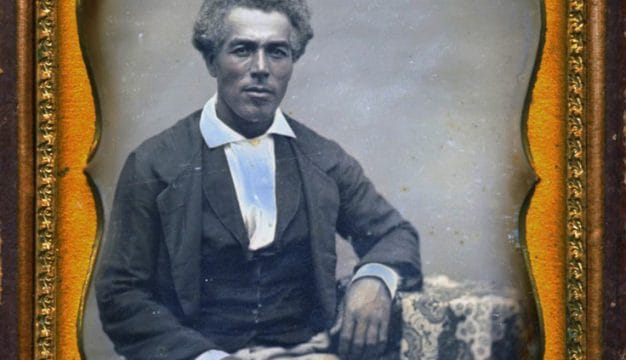Craig Field Airport and Industrial Complex (Craig Air Force Base)
Located four miles southeast of Selma, Dallas County, Craig Field Airport and Industrial Complex was for many years Craig Air Force Base. It served as a training facility for the United States Army Air Corps for 37 years. Craig currently provides the Selma area with a general-aviation airport and maintenance facilities for military aircraft by civilian contractors.
 Aircraft Maintenance at Craig Field
Initially known as Selma Army Air Base, work on the facility began in 1940 as the U.S. military sought to train more pilots as World War II spread in Europe. The base became active on August 4, 1940, but was nowhere near ready to fulfill its mission of advanced-phase flight training for cadets, which was the last phase before cadets received their wings as rated pilots. Actual training on the base began in the spring of 1941 using temporary runways. Even under these makeshift conditions, more than 50 North American-made AT-6 Texan training aircraft were operating on the field along with various other types of aircraft.
Aircraft Maintenance at Craig Field
Initially known as Selma Army Air Base, work on the facility began in 1940 as the U.S. military sought to train more pilots as World War II spread in Europe. The base became active on August 4, 1940, but was nowhere near ready to fulfill its mission of advanced-phase flight training for cadets, which was the last phase before cadets received their wings as rated pilots. Actual training on the base began in the spring of 1941 using temporary runways. Even under these makeshift conditions, more than 50 North American-made AT-6 Texan training aircraft were operating on the field along with various other types of aircraft.
Initially assigned to the base was the Air Corps Advanced Flying School (Single Engine), consisting of the 21st Single Engine Flying Training Group (90th and 92nd School Squadrons) and the 22nd Single Engine Flying Training Group (380th, 381st, and 382nd School Squadrons). The base’s primary mission was to train pilots on single-engine aircraft. The first class from the program was Class 41D, which graduated 39 cadets just months before the entry of the United States into World War II and just about the same time as the United States Army Air Corps was renamed the United States Army Air Forces on June 20, 1941.
 Flight Instructors at Craig Field
Selma Army Air Base was renamed Craig Army Air Base on August 25, 1941, in honor of Selma-born Lt. Bruce K. Craig, who was killed in the crash of a B-24 Liberator bomber during a flight test. Born in 1914, Craig had an early love for aviation and had earned his civilian pilot wings before graduating from high school in 1931. He attended the Georgia Institute of Technology and earned his bachelor’s degree in aeronautical engineering in 1935. While in college, he joined the Infantry ROTC and was granted a reserve commission upon his graduation. At the time of the crash, Craig was working as a civilian for Consolidated Aircraft Corporation in San Diego, where he was performing flight tests on aircraft being readied for shipment to Great Britain. During a routine flight test, the controls seized on the bomber, causing it to crash in San Diego Bay, killing Craig and three other crewmen. Before his death, Craig had applied for a commission in the Army Air Corps, and this request was granted posthumously, making Craig a lieutenant.
Flight Instructors at Craig Field
Selma Army Air Base was renamed Craig Army Air Base on August 25, 1941, in honor of Selma-born Lt. Bruce K. Craig, who was killed in the crash of a B-24 Liberator bomber during a flight test. Born in 1914, Craig had an early love for aviation and had earned his civilian pilot wings before graduating from high school in 1931. He attended the Georgia Institute of Technology and earned his bachelor’s degree in aeronautical engineering in 1935. While in college, he joined the Infantry ROTC and was granted a reserve commission upon his graduation. At the time of the crash, Craig was working as a civilian for Consolidated Aircraft Corporation in San Diego, where he was performing flight tests on aircraft being readied for shipment to Great Britain. During a routine flight test, the controls seized on the bomber, causing it to crash in San Diego Bay, killing Craig and three other crewmen. Before his death, Craig had applied for a commission in the Army Air Corps, and this request was granted posthumously, making Craig a lieutenant.
 Aircraft Maintenance Training
In October 1941, two permanent, parallel runways, each 8,002 feet long and constructed of asphalt and concrete, were completed. Initially, Craig Army Air Base offered a 70-hour flight program, but the entry of the United States into the war after the December 7, 1941, attack on Pearl Harbor necessitated a shortened program to train more pilots for combat as quickly as possible. Whereas the base primarily remained a single-engine pilot training facility, its mission expanded to include training on the twin-engine, Martin-built B-26 Marauder medium bomber. Also, other allied nations sent cadets to train at the base, including significant numbers of British, French, and Dutch pilots. By the war’s end, more than 9,000 American pilots had graduated from Craig’s flight program. Thereafter, fewer cadets went through the training process as the need for pilots diminished. In 1947, the U.S. Army Air Forces became the United States Air Force, and the base was renamed Craig Air Force Base. With the start of the Korean War in 1950, the 3615th Pilot Training Wing was activated on the base to train additional pilots in September 1950.
Aircraft Maintenance Training
In October 1941, two permanent, parallel runways, each 8,002 feet long and constructed of asphalt and concrete, were completed. Initially, Craig Army Air Base offered a 70-hour flight program, but the entry of the United States into the war after the December 7, 1941, attack on Pearl Harbor necessitated a shortened program to train more pilots for combat as quickly as possible. Whereas the base primarily remained a single-engine pilot training facility, its mission expanded to include training on the twin-engine, Martin-built B-26 Marauder medium bomber. Also, other allied nations sent cadets to train at the base, including significant numbers of British, French, and Dutch pilots. By the war’s end, more than 9,000 American pilots had graduated from Craig’s flight program. Thereafter, fewer cadets went through the training process as the need for pilots diminished. In 1947, the U.S. Army Air Forces became the United States Air Force, and the base was renamed Craig Air Force Base. With the start of the Korean War in 1950, the 3615th Pilot Training Wing was activated on the base to train additional pilots in September 1950.
 Air Corps Cadets at Craig Field
During the Cold War era, Craig Air Force Base pilot training shifted to training flight instructors. In addition to Air Force personnel, pilots from the Marine Corps and Air National Guard also began trained there. After the Vietnam War, Craig Air Force Base again reduced its activities. The last class graduated in August 1977, and the base closed on September 30. The Air Force departure from Craig Air Force Base did not end aircraft operations at the field. Renamed Craig Field Airport and Industrial Complex and managed by the Craig Field Airport and Industrial Authority, the base began a new life as a civilian airport and center for commercial and local government activities.
Air Corps Cadets at Craig Field
During the Cold War era, Craig Air Force Base pilot training shifted to training flight instructors. In addition to Air Force personnel, pilots from the Marine Corps and Air National Guard also began trained there. After the Vietnam War, Craig Air Force Base again reduced its activities. The last class graduated in August 1977, and the base closed on September 30. The Air Force departure from Craig Air Force Base did not end aircraft operations at the field. Renamed Craig Field Airport and Industrial Complex and managed by the Craig Field Airport and Industrial Authority, the base began a new life as a civilian airport and center for commercial and local government activities.
The excellent military facilities that existed on the site, including hangars, machine shops, and related material needed to maintain aircraft, were almost immediately taken over by civilian contractors working on aircraft. Repair and maintenance firm L3 Communication/Vertex Aerospace (based in Madison, Mississippi) operates a facility for both military and civilian government aircraft on the former base. The Alabama Highway Patrol maintains its training academy there as well as the headquarters for its F Troop. The Alabama Department of Corrections also has a training facility on the complex. Although both runways are still present on the field, only one is open for flight operations. There is no manned air traffic control tower, but VORTAC (VHF Omni-directional Radio Range coupled with Tactical Air Navigation) and ILS (Instrument Landing System) systems aide aircraft using the field. Large enough to handle aircraft as big as Boeing 747 and 777 airliners, Craig Field also can be used as an emergency landing site for most aircraft.



